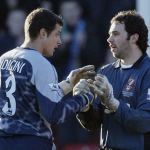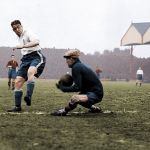
The lost ritual of exchanging the shirt
The story of a gesture that we won't be able to see from next season
May 15th, 2020
Morocco, Stade de Marrakech. On 18 December 2013, the Raja Club Athletic Casablanca and Atletico Mineiro are playing for access to the Club World Cup final against Bayern Munich. The match ends 3-1 for the North Africans, but what strikes the most is what happens immediately after the match: at the final whistle of the referee, the Moroccan players run towards the symbolic man of Mineiro, Ronaldinho. After winning everything in Europe at Milan and (above all) at Barcelona, the Brazilian has decided to return to play at home and, having archived the parenthesis of a year at Flamengo, finds himself fighting for the title of world champion with the club by Belo Horizonte. Although years have passed since his heyday, Gaucho is still a star, and everyone wants his shirt. In the end it was Kouko Guehi, the median, who in the 90 minutes did not miss the opportunity to show his idol all his admiration with several hard interventions. But that's not all: masseurs, technicians, benches and bottle cages, everyone wants to greet and pay homage to "Dinho". Raja's goalkeeper, Khalid Askri, after embracing him asks if he can have his iconic headband. "Do you really want this?", Ronaldinho seems to ask with a surprised face. Askri slips it off his forehead and exultantly takes it away, showing it to his teammates. From that field the Brazilian will come out in his underwear and without shoes: a striptease that is worth a thousand tributes.
However exaggerated and unrepeatable, scenes like this risk disappearing: in fact - as anticipated by the Telegraph - among the security measures for the restart of the Premier League there would be a ban on players to exchange the shirt at the end of the match. A shrewdness that, according to the British media, should also be extended to the whole next season as the practice is in contrast with the health rules necessary to contain the spread of the virus. There is no point in washing the heirloom immediately, as did the mother of Leigh Walker, 22-year-old Scarborough goalkeeper who in 2004 managed to exchange the uniform with Chelsea goalkeeper Carlo Cudicini after an FA Cup match. Walker had even got a dedication from the Italian: "Best wishes for the rest of the season". Needless to say, the signature went away with the wash, leaving the young goalkeeper with a clean shirt and a bad taste in his mouth.

The exchange of shirts at the end of the race was born as a ritual to remember an important sporting moment: in 1931, at the "Yves du Manoir" Olympic Stadium in Colombes (just outside the western suburbs of Paris), the French national team faced for the seventh time in its history England. The score had been bleak: the British had won all previous matches, and the partial was 25 goals to 6. Surprisingly, the friendly match ended 5-2 for France. Excited for the historic victory, the Transalpines asked their British colleagues for their shirts as a souvenir. The British accepted - aware that they are still among the strongest national teams in the world - and demonstrated it, especially to the French, beating them repeatedly in the following years until 1955, the year of the second victory of the Blues.

Soon the gesture asserted itself as a sign of respect for an opponent, a way to recognize the other a certain admiration for ethics, technical skills and value in terms of leadership. An example of all the Champions Cup final of 1962: in addition to beating Real Madrid and becoming European champion, the dream of the then twenty-year-old Benfica Eusebio was to take home the shirt of the Blancos star Alfredo Di Stéfano . He succeeded in both intents. "At the end of the race I had Di Stéfano's shirt in my shorts, I was terrified that someone would take it away from me," the "Black Panther" later declared.
Respect, yes, but with an eye to the context, especially in the event of historical rivalry between the teams: in addition to numerous fair play gestures, the history of shirt exchanges is dotted with unpleasant events, above all the exchange denied in the quarterfinals World Cup final of 1966 between Argentina and England, ended 1-0 for the British. The match, described by the press of the time as "aggressive" and "fiery", ended with the race of the English manager Alf Ramsey, who traveled the whole field to prevent the stopper George Cohen from exchanging the shirt with the Argentine Alberto Gonzales, defining the latter "an animal that does not deserve the English uniform". An episode that helped kick off a rivalry, that between Argentina and England, which throughout history has also intertwined with politics, culminating with the famous "Mano de Dios" of Maradona twenty years later at the World Cup '86.

The antagonism between Arsenal and Manchester United is certainly no less. For this reason, the Gunners fans did not consider the choice of the left outsider André Santos in 2012 to exchange the shirt with Robin Van Persie, who had spent the year before at the Red Devils from Arsenal. To draw the ire of the fans was the unhappy decision of Santos to ask - and obtain - the exchange during the interval, under the eyes of all in front of the tunnel that leads to the changing rooms. On the other hand, rejecting the shirt of a rival team may mean eternal glory in the eyes of its fans and Afriyie Acquah, Turin midfielder who at the end of a derby in 2016 refused the exchange with Juventus player Bonucci, one of the most targeted by grenade supporters. A few years earlier, on the occasion of the first stracittadina after the return to Serie A of Turin, at the end of the match Ogbonna had accepted the black and white shirt of Marchisio, irreparably breaking the relationship with his fans.
What makes the difference is the fate of the "rival" shirt obtained at the end of the match: on the sidelines of a Milan-Lazio of last year, Bakayoko and Kessie showed triumphantly and with a mockery the Acerbi uniform exchanged shortly before, attracting criticism of all the national press. The situation is different if your name is Alessandro Del Piero. In March 2013 the Juventus captain celebrated his Juventus' victory over Milan under the stadium curve wearing the shirt of Seedorf, but given the caliber of the two champions the thing was interpreted by both fans as a simple sign of mutual affection.
On the other hand, when we talk about players of this level we tend to forgive everything and it is for this reason that Ronaldinho was able to exchange his Barcelona shirt with Paolo Ferreira of Chelsea during the interval of an eighth final of the 2004 Champions League without generating particular sensation. In the first half of that match, however, the Brazilian made two goals, the second of which from the edge of the area entered the history of the most beautiful goal of the competition.
An iconic shirt - the away one of the Catalans of that year - because the first worn by Leo Messi at the beginning of the club. Pulga herself said she had never tried to swap shirts with anyone, except for a historical rival, Zinedine Zidane. At Santiago Bernabeu, after a 3-0 win against Barcelona against Real Madrid, Leo was unable to hide his admiration for Zizou and obtained the only exchange he has ever sought. Despite the sporting rivalry, the Argentine has always defended the French, especially after the latter's decision to announce his retirement. "I am surprised too, but nobody has the right to criticize him," said the "Pulce" to the Mundo Deportivo.
Messi also revealed that he willingly accepted exchanges with other opposing Argentinian players who asked him to. In 2016 Bonucci and Chiellini argued during the first half of a Barcelona-Juventus to "book" the 10 Blaugrana shirt at the end of the game, a scene similar to that of 2003 when Javier Zanetti and Marco Materazzi simultaneously offered their shirt in exchange for that of Henry.

The most coveted of all, however, would appear to be that of Pele: the shirt he wore during the World Cup final in '70, exchanged with Roberto Rosato, was auctioned by the Italian and sold for a record amount of 180 thousand euros. During that same tournament, in the group stage the Brazilian phenomenon exchanged the uniform with that of the Englishman Bobby Moore, in a shot that the British media of the time called "a huge slap to racism". During his stay at the New York Cosmos, Pelé confessed to always pruning two dozen shirts with him, to try to satisfy anyone who asked him during the various games of the season.
A real "slap to misery" if you think that to reduce spending in 2016, Manchester United asked its players to refuse any exchange of shirts, under penalty of having to pay out of their own pockets for a new uniform. Similar speech for Iran of the 2014 World Cup: the president of the football federation Ali Kafashian explained that due to the profound economic crisis facing the country it would not be possible to provide the players with a shirt for each game, asking them to avoid exchanges with their opponents .
Whether it's a tribute to a rival or a ritual to get a heirloom or a mockery, we should say goodbye for a while to a custom - that of swapping shirts - almost as old as football itself. Hoping that it will soon be a symbol of class and sportiness again, as when Parma and Sampdoria decided to celebrate the friendship between their fans by exchanging the historical designs of their respective uniforms: the cross passed on the Genoese shirt, while vertical bands adorned the shirt of the Emilians in an initiative that took the name of "Blucerchiati".






























